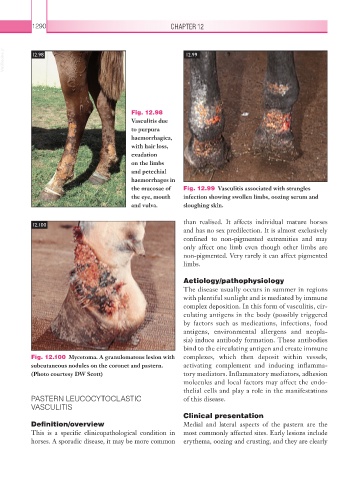Page 1315 - Equine Clinical Medicine, Surgery and Reproduction, 2nd Edition
P. 1315
1290 CHAPTER 12
VetBooks.ir 12.98 12.99
Fig. 12.98
Vasculitis due
to purpura
haemorrhagica,
with hair loss,
exudation
on the limbs
and petechial
haemorrhages in
the mucosae of Fig. 12.99 Vasculitis associated with strangles
the eye, mouth infection showing swollen limbs, oozing serum and
and vulva. sloughing skin.
than realised. It affects individual mature horses
12.100
and has no sex predilection. It is almost exclusively
confined to non-pigmented extremities and may
only affect one limb even though other limbs are
non-pigmented. Very rarely it can affect pigmented
limbs.
Aetiology/pathophysiology
The disease usually occurs in summer in regions
with plentiful sunlight and is mediated by immune
complex deposition. In this form of vasculitis, cir-
culating antigens in the body (possibly triggered
by factors such as medications, infections, food
antigens, environmental allergens and neopla-
sia) induce antibody formation. These antibodies
bind to the circulating antigen and create immune
Fig. 12.100 Mycetoma. A granulomatous lesion with complexes, which then deposit within vessels,
subcutaneous nodules on the coronet and pastern. activating complement and inducing inflamma-
(Photo courtesy DW Scott) tory mediators. Inflammatory mediators, adhesion
molecules and local factors may affect the endo-
thelial cells and play a role in the manifestations
PASTERN LEUCOCYTOCLASTIC of this disease.
VASCULITIS
Clinical presentation
Definition/overview Medial and lateral aspects of the pastern are the
This is a specific clinicopathological condition in most commonly affected sites. Early lesions include
horses. A sporadic disease, it may be more common erythema, oozing and crusting, and they are clearly

